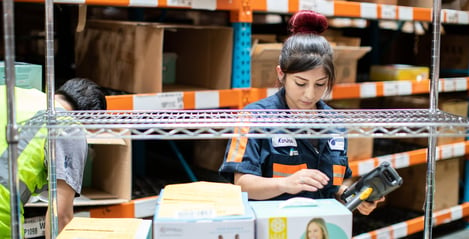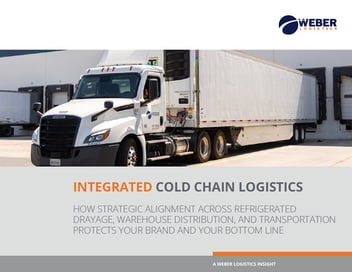Weber's new eBook, A Guide to Outsourcing Omni-Channel Fulfillment to a 3PL, identifies 7 key characteristics you should look for in a 3PL provider that can handle both your B2B and B2C fulfillment ops. The following is an excerpt of the full (free) eBook, which you can access below.
Your company doesn’t sell B2B products or B2C products, it sells products – regardless of the way they’re distributed. Why then do many companies take a siloed approach to product fulfillment by storing products for B2C and B2B distribution separately, with different systems to manage inventory and orders for each?
If this doesn’t make sense to you either, welcome to the world of omni-channel fulfillment. To accomplish omni-channel effectively, you can lean on a third-party logistics (3PL) provider that has the infrastructure and systems smart enough to be your fulfillment provider for ALL your sales channels.
7 key characteristics of an omni-channel 3PL provider
1. Your 3PL has B2C expertise
Even if your company has been historically focused on B2B fulfillment, chances are that eCommerce has become a more integral part of your business. However, B2C fulfillment is a much different animal than B2B/retail. The following are just some of the key considerations for your company when partnering with a 3PL for eCommerce/pick and pack operations.
 B2C systems are different than B2B. With B2C/eCommerce fulfillment, orders are processed through a selling platform like Shopify, BigCommerce or Magento. From there, integration between such a system and your warehouse management system (WMS), or that of your 3PL provider, is needed so that the WMS can create an order, modify inventory, print labels, and drive efficient picking, packing and shipping. In addition, the WMS needs to integrate with a parcel system to manage the processing of the order for shipment with the correct carrier, as well as the service type and rates as designated by the order. Your 3PL can set up all these integrations on your behalf.
B2C systems are different than B2B. With B2C/eCommerce fulfillment, orders are processed through a selling platform like Shopify, BigCommerce or Magento. From there, integration between such a system and your warehouse management system (WMS), or that of your 3PL provider, is needed so that the WMS can create an order, modify inventory, print labels, and drive efficient picking, packing and shipping. In addition, the WMS needs to integrate with a parcel system to manage the processing of the order for shipment with the correct carrier, as well as the service type and rates as designated by the order. Your 3PL can set up all these integrations on your behalf.- Speed is a vital B2C concern. While speed is, of course, a consideration with B2B fulfillment, there’s typically a predictable cadence. You and your retail partners agree on delivery times and you make sure that your orders are fulfilled on time, in full. B2C is far less predictable. Orders can come in at a snail’s pace one day and then fast and furious the next (e.g., due to promotions or social media activity). You need a B2C fulfillment provider that can scale to handle your order volumes with equal ease so that customer expectations for fast delivery can be met.
- Product packaging/appearance is customizable. When you ship to a retailer, that retailer puts your products on the shelves for customers to see and purchase. In the B2C world, there is no step between the warehouse and the customer. The product packaging, safety and presentation that drive the customer experience are dependent on what happens within the warehouse. Some products will require different materials to ensure safety and/or to embellish the presentation. Everybody involved needs to be clear on what a ‘perfect order’ is, and warehouse associates must have the training to execute each order flawlessly.
2. Your 3PL has B2B expertise
There are several key differences between B2B and B2C fulfillment. The following are two of the most important ones.
- Vendor compliance is paramount. When you work with a retailer, you – or your fulfillment partner – must follow the retailer’s routing guide, which outlines a very specific set of requirements for shipping orders to them. These include shipment preparation and delivery appointment scheduling guidelines that ensure your products are provided to the retailer exactly as it wants them. Importantly, every retailer’s routing guide is different, so you’ll need to deliver products in different configurations to different retailers. Failure to follow these requirements to the letter will result in expensive chargebacks which have become more stringent and more prevalent in recent years. Many 3PLs have been doing retail compliance for years and can help you meet the requirements and ramp up quickly.
- Systems integration can be time-consuming. Systems integration issues can really derail start-up operations with a new retail customer. This is one of the reasons companies choose to partner with 3PL providers that have an in-house IT team. When such providers are also retail logistics experts, it’s likely that they have already integrated with the retailer and can avoid the coordination of outsourced IT vendors. This can reduce the timeframe for system integration from months to weeks.
3. Your 3PL systems can fulfill B2B and B2C orders from same inventory
Your 3PL’s WMS system acts as the central hub of warehouse operations, from inventory management and order tracking to metrics reporting and labor management. As part of this, your 3PL’s WMS system can manage inventory for omni-channel distribution in real time. With such a system, you can keep inventory levels low as all orders are fulfilled from the same inventory pool. This allows you to reduce your warehouse footprint and storage costs.
Your provider’s WMS system can also be an ally in your efforts to adhere to retailer vendor requirements. Just about every aspect of your warehousing operations can be hard coded to comply with these requirements. This includes generation of labels and pack slips, order tracking, and real-time reporting of the metrics important to your retail partners.
Your 3PL’s WMS can also provide real-time access to the information and KPIs most important to your business. Many WMS systems allow for seemingly endless customization of inventory, order, labor, and productivity metrics across multiple clients.
Such sophistication comes at a price, of course. A robust WMS system can cost well into the six figures. But it’s not an investment you need to make yourself, as most 3PLs already have top-tier WMS systems in place. By outsourcing warehousing services to a 3PL provider, you can simply connect your operation to its WMS while sharing the costs with the provider and its other customers.
To read the 4 additional 3PL characteristics, simply click the link below.




 Capital Management
Capital Management